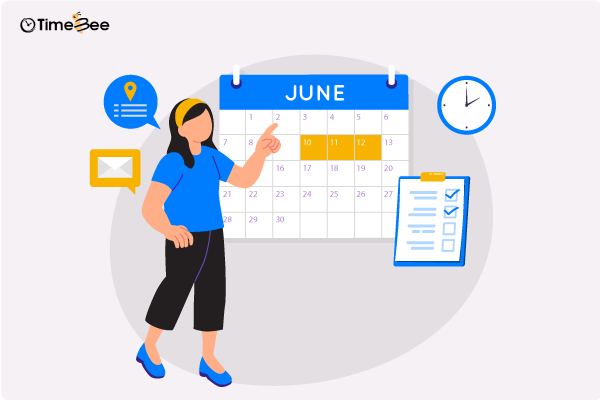Content
Content
Company policies are made to create a balance in the organization, where every employee is treated equally, and there is no room for favoritism or bias. They also state what the organization expects from its employees so that management doesn’t have to narrate company values to recruits.
An attendance policy offers a structure that ensures operational efficiency and workplace discipline, creating a fair, accountable, and positive workplace culture.
In this blog, we will discuss how to create a good employee attendance policy that aligns with the company’s goals and is in the best interest of employees.
What is an Employee Attendance Policy?
An employee attendance policy is a formal document that outlines a company’s expectations regarding staff presence, punctuality, and procedures for reporting absences. It is also a detailed document that clarifies the company’s leave format, e.g., the type, number, and acceptable reasons for absences.
Further, the attendance policy provides a framework for addressing attendance-related issues. For example, a company may state that employees must report unplanned absences at least one hour before their shift starts.
In addition to the company’s benefits, an attendance policy ensures compliance with labor laws and regulations related to employee rights. Crafting a good attendance policy requires an understanding of employee behavior and the impact of their attendance behavior on the organization.
Terms used in Attendance Policy
Before creating an attendance policy, you need to understand a few terms.
- Absenteeism:
The frequent absence of an employee from their work duties without valid reasons.
- Presenteeism:
When an employee is constantly present at work despite being unwell.
- Leave or Excused Absence:
A period during which an employee is allowed to be away from work for various reasons, such as medical leave or personal leave.
- Tardiness:
When an employee arrives late to work or returns late from breaks.
- No-Call, No-Show:
When an employee fails to report to work without notifying the employer.
- Unexcused Absences:
When an employer doesn’t approve the leave and the employee doesn’t show up, such leaves are usually unacceptable and may lead to disciplinary actions.
- Accrual:
The process of earning paid leave over time is typically based on hours worked.
- Disciplinary Action:
These are progressive measures taken to address attendance violations. They can range from verbal warnings to termination.
12 Steps to Craft an Employee Attendance Policy
Creating an effective employee attendance policy involves several vital steps to ensure it is comprehensive, clear, and aligned with organizational goals and legal requirements. It also requires input from the management and stakeholders.
Once you understand what you want to include in your policy, you have to align it in a user-friendly way. Here’s a step-by-step approach to creating your attendance policy.
1. State Purpose and Scope
The first and foremost step is to define the purpose of the attendance policy. Describe in detail why you are implementing this policy and what the organization aims to achieve. The purpose should include productivity goals, employee morale, and operational needs.
Also, include goals such as reducing absenteeism, ensuring fair treatment of all employees, and creating a healthy working environment.
To define the scope, specify to whom the policy applies. For example, you can write all employees, specific departments, or particular organizational roles. The scope ensures that everyone understands whether and how the policy affects them.
2. Comply with Legal Requirements
Your policy should meet all the legal requirements. Research the laws regarding attendance and associated compensation and include them in the policy. Per general labor laws, your policy should state the minimum paid leave employees are legally entitled to, notification requirements, and accommodations.
Consult a legal professional for guidance on specific regulations in your region.
3. Define Attendance Expectations
Once acquainted with labor law, combine it with company goals and write down daily or weekly work-hour expectations. This section includes the core hours where employees must be physically present, break time for meals and rest.
Moreover, establish specific attendance expectations for remote workers or any particular job type.
4. Elaborate Absence Procedures
Provide step-by-step procedures for reporting absences. This should include the notification Process, i.e., how and when employees should notify their supervisors about their absence. Specify the acceptable methods of communication, such as phone calls, emails, or an online reporting system.
Furthermore, you need to state the required notice period for reporting different types of absences, such as one hour before the shift for unexpected absences or one week’s notice for planned vacations.
Mention the requirement of any necessary documentation or proof of leave, such as medical certificates for sick leave.
5. Define Types of Leave
Outline the various types and numbers of leave the organization offers employees. These may include;
- Sick Leave: For illness or medical appointments.
- Vacation or Annual Leave: Planned time off for vacation or holiday.
- Personal Leave: For non-medical reasons, including family emergencies or personal matters.
- Other Leaves: Leaves that happen due to maternity/paternity leave, loss of leaves, jury duty, etc. Also, mention the approval metrics for such leaves.
6. Address Unplanned Absences
Define the procedures for reporting unplanned absences. Also, mention what qualifies as unplanned leave and what evidence is required for approval. These leaves may include emergencies and unexpected illnesses.
7. Implement a Tracking and Recording System
Choose an effective system for tracking and recording attendance. From manual timesheets to sophisticated timekeeping software, there are many options available. However, it is more important to choose an option with more authentic real-time statistics that help you comply with labor laws. Here are a few systems that you can add in.
- Manual Time Sheets: Preferred method for smaller businesses. Manual entries record time, so they are not very reliable.
- Time Clock System: Traditional method for physically clocking in and out.
- Time-Tracking Software: Time-tracking software is a more advanced and reliable option that offers flexibility and data analysis capabilities.
Looking to Develop Time Policy and Manage Attendance?
Get TimeBee Today
8. Describe Consequences for Violations
Include state the consequences for violating the attendance policy so that employees know beforehand how the organization observes them. This section should include verbal or written warnings for initial infractions. Also, mention what is considered an initial infraction.
The next step would be disciplinary action. Ensure the disciplinary actions are fair, consistent, and aligned with the organization’s broader disciplinary policy.
Explain the guidelines for when termination might be considered due to chronic absenteeism or severe violations.
9. Include Accommodations and Exceptions
Provide detailed information on accommodations and exceptions for specific situations. Include reasonable accommodations for employees with disabilities or chronic illnesses. Also, include accommodation for other employees in a medical or family emergency.
Moreover, the leaves for legal obligation should be included if the management deems fit.
10. Establish Reporting Procedures
Clearly define the reporting procedures, i.e., how managers should handle attendance issues. It should state that they must review employee timekeeping records regularly. Moreover, if or not approving the leaves of a team member is the manager’s responsibility, write down the approving procedure for both parties.
Also, the consequences for violations should be listed if the employee fails to report a leave per the policy.
11. Review the Policy
Once you have developed the policy, review it thoroughly to see if you have missed anything. Ensure that it is relevant and aligned with the organization’s changing needs. Revise it if necessary to improve policy effectiveness.
To check the legal compliance, have it reviewed by professional legal counsel.
12. Communicate the Policy
Once the policy is finalized, communicate it to the team. Ensure the policy is communicated effectively, and ask the employees if they want to clarify anything.
Use multiple channels to disseminate the information, such as employee handbooks and staff meetings. Consider holding training sessions or workshops to explain the policy and address any questions or concerns.
TimeBee for Tracking Attendance
Once you have created and implemented the policy, you need to track attendance. There are several ways to track attendance; however, if you want up-to-date and innovative attendance software, get TimeBee.
TimeBee is a time-tracking and employee-monitoring tool that provides reliable insights into employee attendance. The app’s innovative features ensure all employees understand and comply with the policy. Let’s see how its features can help you implement your attendance policy.
Get Detailed Attendance Reports
TimeBee offers comprehensive attendance reports that provide valuable insights into employee attendance patterns and trends. The reports include the following information.
- Short Hours: When an employee has not met the total hours management requires.
- Late Arrival: When an employee arrives later than their designated start time.
- Early Leave: When an employee leaves before their designated end time.
- Absent: When an employee is not present for the day.
- Total Hours Tracked: The total hours an employee worked in a day.
This data helps accurately track employee attendance and identify whether or not the employee is following the policy. You can extract insights about absenteeism and tardiness and use the data to decide how to overcome the attendance issue.
The report is usually week-based; however, with the customizable calendars, you can choose a required week to check attendance. Additionally, you can export attendance reports in PDF format for further analysis or share them with stakeholders.
Time Tracking
TimeBee’s time-tracking feature ensures accurate and efficient tracking of employee work hours. This feature helps maintain precise records and significantly streamline time management processes.
Employees can start the time to start recording when they arrive after work and stop the timer when they leave. In addition to clock-in and clock-out times, TimeBee’s time tracker also records the employee’s breaks during working hours. This data helps understand the employees’ working patterns.
Productivity Analysis
In addition to Attendance reports, TimeBee generates various productivity reports to help organizations understand how employee attendance correlates with overall productivity. These performance metrics can give businesses insights into improving efficiency and productivity.
TimeBee tracks time against tasks and projects. You can compile data on how much your employee has worked on the tasks and compare it with the standard you have set based on the attendance ratio. Also, with the web and application reports, you can analyze how much time the employee spent on productive sites and calculate their presentism.
In addition, this system identifies trends and patterns in attendance that show absenteeism during peak periods or consistent tardiness in specific departments. This data gives you actionable insights to help you decide on accruals or disciplinary actions to improve overall efficiency.
Conclusion
Employee attendance policy is one of the significant company policies. It is essential for maintaining productivity, ensuring legal compliance, and promoting a positive workplace culture. Clearly defining expectations, procedures, and consequences provides a transparent framework that benefits employees and the organization.
Crafting an attendance policy won’t serve its purpose until appropriately implemented. To check the adherence to the policy that offers a deep analysis of employees’ time, which TimeBee can achieve. This app can enhance attendance management efforts, providing accurate data and streamlining processes. Take the time to craft a comprehensive policy and get TimeBee to maintain and monitor attendance effectively.
Set Clear Attendance Guidelines for Your Team!
Get TimeBee Today
Similar Reading



